A History of the Farmington Community
- Beginnings
- Commerce
- Education
- Founders
- Government
- Religion
- Social Life
- Transportation
- Underground Railroad
Beginnings: An Introduction
People interested in the histories of Farmington and Farmington Hills benefit greatly from the work of others who chose to spend time documenting the lives and times of our community.
In addition to the persons whose work appears in the Sources, special appreciation is due to:
- The late Lee S. Peel, noted Farmington historian, who edited the manuscript for the Farmington history section of this document. Mr. Peel's 1971 edition of Farmington: A Pictorial History was heavily used in the 1978 print edition of this compilation. The Library was, indeed, fortunate to have had Mr. Peel's expertise in development and maintenance of what would become the Library's Heritage Collection.
- Denise Moll, the employee of the Farmington Community Library who compiled the first capsulized history of the Farmington area in 1978. In her research, Ms. Moll used the publications of Mr. Peel, Ruth Roth Moehlman, monographs from the Farmington Hills Historical Commission, and primary source articles from the Farmington Enterprise and its later incarnation, the Observer.
- The tireless work of all the highly dedicated volunteers who diligently maintain and develop the Library's Heritage Collection and its home, the Heritage Room in the Main Library, and who so generously share their rich expertise and interest with our community.
- We suggest those interested in this topic check out the Heritage Collection pages on the Library's Web site, especially the online slide show, Farmington: 1824–1989.
- The Historic District Commission (City of Farmington Hills) has created an overview of the Historic District Properties. It is available for viewing as a large (nearly 10MB) .pdf document, as well as a map of structures in the Historic District.

Beginnings: PreHistory—Farmington and The Defiance Moraine
 Twelve thousand years ago the last glacier crept across the face of the land, piling up debris, carving lakes, rivers, and streams, altering the geography and determining the use of the land for centuries to come. Its changes can easily be seen in the Farmington area. As the glacier pushed through, it left piles of rubble in its wake, called moraines. The Defiance Moraine, so named because it runs to Defiance, Ohio, can be clearly seen from Twelve Mile Road, its Outer Ridge rising to Halsted, the Inner Ridge east of Drake Road.
Twelve thousand years ago the last glacier crept across the face of the land, piling up debris, carving lakes, rivers, and streams, altering the geography and determining the use of the land for centuries to come. Its changes can easily be seen in the Farmington area. As the glacier pushed through, it left piles of rubble in its wake, called moraines. The Defiance Moraine, so named because it runs to Defiance, Ohio, can be clearly seen from Twelve Mile Road, its Outer Ridge rising to Halsted, the Inner Ridge east of Drake Road.
As the glacier advanced and retreated, it carved what is now the Lake Erie Basin. Several lakes developed in this area, but they were not destined to remain. The beach ridge of four of these lakes can be seen as gently sloping elevations in the southeast portion of the Farmington area.
Most of the area is covered by glacial till, 100 to 200 feet thick, making it good farm land.

Beginnings: The Indian Influence
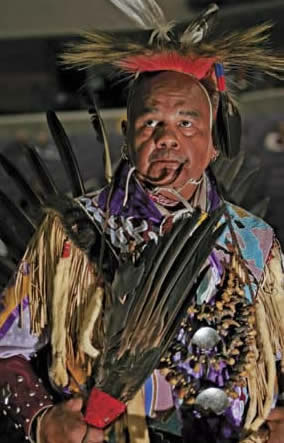 Shortly after the glacier age ended, men began to populate the area. They had come from Siberia, across what was once a land bridge crossing the Bering Sea to Alaska. From Alaska the people fanned out over North America, one group settling eventually in and around Michigan. These people, the Potawatomi Indians, inhabited the lands now known as lower Michigan, northwestern Ohio, Indiana and northern Illinois. In the Farmington area it is believed they settled in the northwest section, near a lake known as Minnow Pond, now a treacherous marsh. The land surrounding Minnow Pond was fertile, encouraging agriculture; and an abundance of wildlife could be found, making this a hunting ground center. It is believed that the legend of the Potawatomi curtain originated at Minnow Pond. The "curtain" was in legend the accumulated smoke of the many Indian hunters' campfires that had burned at campsites on the ridge around the pond. In reality, the Curtain is the night mist, settling over the valley and pond, enveloping the area in a smoky haze.
Evidence of the Potawatomi's presence can still be seen, though it is fast disappearing. Indian remains and artifacts have been found on several farms and fields. The 1976 publication, Farmington: An Original Entity, Being the Natural History of Farmington—From Ice Age to Space Search, included mention of a large earth mound located about a mile west of Minnow Pond which was believed to contain ancient Indian artifacts. At that time, the University of Michigan had the option to exercise its digging rights for the contents. However, there is no record of such a digging expedition having taken place. A trail marker tree, which as a young tree was man-shaped into a U or Y to indicate an Indian trail, could for many years be seen at the southwest corner of Drake and Howard roads.
Shortly after the glacier age ended, men began to populate the area. They had come from Siberia, across what was once a land bridge crossing the Bering Sea to Alaska. From Alaska the people fanned out over North America, one group settling eventually in and around Michigan. These people, the Potawatomi Indians, inhabited the lands now known as lower Michigan, northwestern Ohio, Indiana and northern Illinois. In the Farmington area it is believed they settled in the northwest section, near a lake known as Minnow Pond, now a treacherous marsh. The land surrounding Minnow Pond was fertile, encouraging agriculture; and an abundance of wildlife could be found, making this a hunting ground center. It is believed that the legend of the Potawatomi curtain originated at Minnow Pond. The "curtain" was in legend the accumulated smoke of the many Indian hunters' campfires that had burned at campsites on the ridge around the pond. In reality, the Curtain is the night mist, settling over the valley and pond, enveloping the area in a smoky haze.
Evidence of the Potawatomi's presence can still be seen, though it is fast disappearing. Indian remains and artifacts have been found on several farms and fields. The 1976 publication, Farmington: An Original Entity, Being the Natural History of Farmington—From Ice Age to Space Search, included mention of a large earth mound located about a mile west of Minnow Pond which was believed to contain ancient Indian artifacts. At that time, the University of Michigan had the option to exercise its digging rights for the contents. However, there is no record of such a digging expedition having taken place. A trail marker tree, which as a young tree was man-shaped into a U or Y to indicate an Indian trail, could for many years be seen at the southwest corner of Drake and Howard roads.
Farmington was the site of three Indian trails, the Orchard Lake Trail, the Grand River Trail and the Shiawassee Trail; each generally followed the now-used roads of the same name.

Commerce
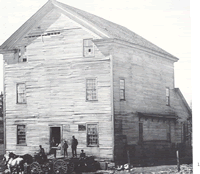
The rapidly growing township was attractive to several types of business. As the area developed, the enterprises became more diverse in response to the changing needs of the residents.
The primary business of the first settlers was, of course, agriculture. Soon enterprising men put the Rouge River to work as saw mills and grist mills, much the same as those that were springing up all over Michigan. One of the first was Arthur Power's Old Eagle Mill. Unfortunately, because of its location, the Old Eagle Mill was not very successful. The Rouge River was not strong enough to support a mill, especially in that part of the township. This, coupled with the fact that the engineering of the dam was not the best, meant that production was slow and unpredictable. A dry season halted operations altogether. As trees were cut, the soil lost its ability to retain water; the lower water table weakened the Rouge to the point where it was powerless. The mill fell victim to the very ecological conditions that it had helped to bring about.
The Steele Mill, known in the 1860's as the Hardenburg Mill, with its better location on the Rouge, was a more successful venture. Built in Pernambuco Hollow in the north area of the township, the Steele Mill was a center of activity in the area, offering a cooper's shop, soap factory, and store, as well as a saw mill and grist mill. While other mills converted to cider mills, tried conversion to steam power or fell victim to fire, the Steele Mill continued its operations until 1904, when a flood swept out the dam.
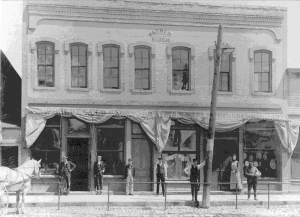 The first twenty years of the town's development saw the establishment of merchants' shops, an undertaker, a small foundry, a potash plant for making soap, and dairies and cheese factories, the last of which remained until World War II. The main business in the North and Western sections of the township was apple and small fruit orchards; produce was sold at Detroit's Eastern Market. An example of this business was Button Orchards, located on Twelve Mile Road near Drake, run by descendants of John C. Button.
The first twenty years of the town's development saw the establishment of merchants' shops, an undertaker, a small foundry, a potash plant for making soap, and dairies and cheese factories, the last of which remained until World War II. The main business in the North and Western sections of the township was apple and small fruit orchards; produce was sold at Detroit's Eastern Market. An example of this business was Button Orchards, located on Twelve Mile Road near Drake, run by descendants of John C. Button.
The period of 1850-1890 was a period of growth for merchants, but the agricultural industry rose as the dominant factor of the community. According to the 1870 census, Farmington had 16,514 acres of farmland valued at $1.4 million; machinery was valued at $43,900. Livestock was valued at $186,880, including 642 horses, 1,117 cows, 22 oxen, 5,378 sheep and 1,060 pigs. The harvest included: 1,442 bushels of spring wheat; 42,201 bushels of winter wheat; 38,175 bushels of Indian corn; 39,127 bushels of oats; 36,780 bushels of potatoes; and 75,775 pounds of butter. Orchard produce brought in $16,880.
The agricultural dominance was also reflected in the businesses of the town, including blacksmith shops, harness shops, and farm implement and repair shops.
The average wage of 1870 was $1.00 per a twelve to fifteen-hour day. Carpenters made 15 cents an hour, stone and brick masons earned 20 cents. One could purchase a suit for $20; butter for 20 cents a pound; eggs, 10 cents a dozen; and pork sold for 8 - 10 cents a pound. Not a home in Farmington at that time cost over $1,000.
The 1870's saw the transition of the central business area from Shiawassee to Grand River, to be closer to the center of activity. The E. C. Grace Dry Goods Store was established at Grand River and Farmington; it is now the Korner Barber Shop. A few doors to the east was the O. B. Smith Drygoods store, where a major fire broke out in October, 1872. The volunteer fire brigade was unable to control the fire, having only two wells nearby as a water supply, which soon ran out. The spread of the fire was finally halted when a house was torn down, creating a gap too large for the fire to jump, but not before the flames had ruined Smith's Store, Dr. Woodman's Drug Store, W. B. Shelly and Porter Shephard's Store, the Masonic Hall and the Township Office, including many township records.
A new Town Hall was constructed in 1876, a two-story brick building, 30' by 60', built at a cost of $4,300. The Masonic Lodge leased the upper portion of the building for $1,150, rather than replacing their facilities. Other rebuilding and new construction included a hotel, two saddlery and harness shops, three blacksmith and carriage shops, two wagon shops, a foundry, sawmill and a grist mill.
The first Farmington newspaper, the Enterprise, was published on November 2, 1888, by Edgar R. Bloomer and his printer's devil Fred Cook. The paper, having undergone various owner and name changes, is still the main local newspaper, now known as the Farmington Observer.
In the 1890's business continued to flourish, dominated in many areas by Fred and P. D. Warner. Fred owned a hardware store; he was the manager of the Farmington and Franklin Cheese company, and had interests in the Warner Dairy, Warner Buckmaking Company and Warner Drygoods. P. D. Warner was involved in private banking.
Another well-known merchant was Fred Cook, owner of Cook's Drygoods, later carrying groceries and shoes, crockery and firearms. While no groceries were sold, one could purchase everything else from gingersnaps to "Black Cat" hosiery and "American Lady" corsets.
Business in the Gay Nineties saw the branching out of various specialty shops. Custom made boots and shoes could be had from H. W. Habermehl. Miss Marie Gill offered dressmaking services in her millinery shop beginning in 1893. A meat market and vegetable store was established by Henry Schroeder, and barbers M. B. Pierce and C. W. Chamberlain offered their tonsorial talents in two new shops. Chamberlain, not one to leave success in his competitive business to chance, also sold cigars and offered clock and watch repair services.
At the turn of the century, the sprouting businesses reflected both the needs of the past and advent of a new age of technology. Two new blacksmith shops opened, one at Grand River west of Farmington Road, the other at Farmington and State Street. In 1910, the Nelson sisters announced the opening of their ice cream shop, west of Farmington Road on Grand River, where the municipal parking lot is now. The telephone arrived; several pay stations were set up in stores by the Michigan State Telephone Company. The local exchange was operated by Mr. and Mrs. C. M. Doherty, in their combination telephone office and tin shop.
It was not long before the automobile began its takeover, first with a repair shop on Grand River in a building that in 1970 was the Precise Tool Company, then with the establishment of a Ford sales and service shop on Grand River in 1915. Two other dealerships, Chalmers and Overland, operated on a part-time basis, predecessors of the several full-fledged dealerships that would spout up in the Twenties.
As in all towns, a few "undesirable" businesses were established. William Walters ran a pool room where the Old Village Inn is now: J. E. Phelps, perhaps in an attempt at discretion, advertised the sale of paints and brushes at his pool parlor.
Business continued to flourish during the first half-century. The Farmington area was not hit hard by the depression because it was basically a rural population; its economy was more dependent upon the earth than on stores. The decade of the Thirties saw business continuing somewhat as usual. The Farmington Dairy and Grocery Store sponsored Saturday specials of pork sausage at 25 cents for two pounds, smoked hams priced at 22 cents and butter sold for 24 cents a pound.
The car dealers reported that in August, 1935 (regarded as the depth of the Depression), auto sales were double what they were in 1934, with most customers paying cash. A Kroger store opened where Scott Coburn's saddlery is now located, followed by Dancers Department Store, Bradley Drugs, the Oak Pharmacy at the corner of Farmington Road and Grand River. The Civic Theatre was built in 1936. And, the inevitable happened; the Handmart, Farmington's first hamburger stand, opened for business on the south side of Grand River: the building is now a small accounting office.
There were some casualties; the Peoples State Bank succumbed even as the Farmington State Bank reopened on May 19, 1934 after closing for the 1933 Bank Holiday.
Unfortunately, the closing of the Peoples State Bank was a portent of what the future really held. Progress was halted by the war, which created a lack of building supplies. To the flood of newcomers to the area, the old buildings were tawdry and unappealing. Turnover was rapid, with many of the businesses moving to one of the shopping centers being built in the outlying areas. (One such example is Kroger's, which moved to the Farmington Plaza at Grand River and Orchard Lake Road.) The Farmington State Bank sold out to National Bank of Detroit, which shunned the facility which is now the Village Mall and built its own cubicle on Farmington Road, south of State Street.
The end of the war marked the end of the farming era in Farmington. The land became too valuable to farm, and taxes skyrocketed. Owners sold their farms to developers who created the myriad of subdivisions and shopping centers.
In the 1960's, in an attempt to stimulate interest in the City of Farmington area, a Federal's Department Store was built next to the Downtown Center. A rash of drive-ins and hamburger stands sprang up, anxious to cash in on the new interest in the area, much to the alarm of the downtown business leaders who saw this as a move toward further degradation. New restrictive zoning was designed. The outmoded area was redeveloped by the provision of off-street parking areas, the modernization of some of the older buildings, construction of commercial buildings and three new banks, and the building of new municipal offices.
To upgrade the commercial and industrial base, an industrial park was developed at Eight Mile and Farmington Road at a cost of $7,000,000. As a result, $5,000,000 of equipment and inventory were added to Farmington's commercial value.
Similar steps were taken in the township; commercial and industrial tax bases were needed as business incentive here too. One of the underlying reasons for the incorporation of Farmington Hills was fear that the City of Farmington would annex the valuable township Industrial Park property, near the Ten Mile, Grand River and Halsted Road area.
Leadership in the burgeoning business community fell largely to three groups. The Farmington Downtown Development Authority organizes marketing and promotion activities to benefit the retail development in the downtown area; it insures that the downtown is maintained and coordinates improvements.
The Farmington Hills Economic Development Corporation serves as a facilitator to attract businesses to the area and to initiate studies of needed improvements, such as the boulevard for the Twelve Mile Corridor between Farmington and Haggerty roads and the renovation work on Eight Mile Road. The Farmington/Farmington Hills Chamber of Commerce included about 750 members in 1996; the Chamber actively creates a climate to encourage business growth and development, through legislative advocacy and networking among members.
By 1994, Farmington Hills had seven industrial parks with a total of over 600 acres. The Farmington area had almost 4.5 million square feet of office space, which ranged from $10 to $18.50 per square foot for rental. Occupancy was 87.1%, which was higher than in some surrounding communities.
In 1996, approximately 3,000 businesses are located within the 36 mile area of Farmington/Farmington Hills. The variety of businesses range from large multi-national corporate headquarters to the smaller "Mom & Pop" businesses. Support for the automotive industry is demonstrated by the companies: TRW, Automotive Electronics Division; Robert Bosch; and Nissan Research, among others. Many of the local businesses are active in the export/import of products. The Oakland County Development and Planning Division reported local operations of foreign-owned firms with the following diversity: Japanese, 23 firms; German, 9; Italian, 4; French, 3; Canadian, 2; Mexican, 2; Dutch, 2; Swiss, 2; Swedish, 1; and British, 1.
With increased mobility in suburban transportation, gone are the days when the majority of residents work in close proximity to their homes. In 1990, approximately 90% drove to work alone and the average travel time was 23 minutes. Less than 1% used public transportation while 6% used carpools. Only 3% either walked or worked at home.
The relative upward mobility of the residential community adds to the desirability of the Farmington area as a place for businesses to locate. The upward mobility was a trend noted in the changes from the 1980 to the 1990 census figures which showed a high increase in the percentage of people in executive, administrative, managerial and professional positions. For Farmington, the percentage of adults over age 16 in those categories changed from 15% to 41% and for the Hills the percentage went from 19% to 45%.
The national shift of employment to the service sector was mirrored in the Farmington area as well with 36% of the Hills' working population and 34% of Farmington's workers classified as service employees.
By the end of the first decade of the 21st century, the commercial climate again changed in response to greater population stability and economic downturns. These are succinctly summarized in the Oakland County Development Profiles for the cities of Farmington and Farmington Hills, respectively.

Education
See Also:
- An Online Slide Show of Historic Schools in the Farmington Area
- Nathan Power's Pride: An Historical Overview of the Farmington Schools 1944–1988.
- The Education and Schools section of the Our Community Web page.
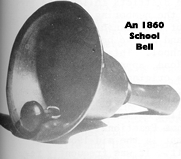 As the spiritual needs of the settlers were provided by the churches, educational needs remained to be met. According to the 1993 book, If Walls Could Talk: Heritage Homes of Farmington by Ruth Roth Moehlman, the first school in Farmington was established in 1826. Teacher Nathan Power taught in a small log building near the creek. Miss Parley Ann Mead was the first lady teacher. A male teacher in those days received a higher salary than a lady teacher. Power operated a farm as his main livelihood, with teaching as a side occupation during the slack season of farming. There were no desks. Children sat on split log benches. While teaching, Power also helped in the actual construction of the school buildings.
As the spiritual needs of the settlers were provided by the churches, educational needs remained to be met. According to the 1993 book, If Walls Could Talk: Heritage Homes of Farmington by Ruth Roth Moehlman, the first school in Farmington was established in 1826. Teacher Nathan Power taught in a small log building near the creek. Miss Parley Ann Mead was the first lady teacher. A male teacher in those days received a higher salary than a lady teacher. Power operated a farm as his main livelihood, with teaching as a side occupation during the slack season of farming. There were no desks. Children sat on split log benches. While teaching, Power also helped in the actual construction of the school buildings.
On May 3, 1830 the Township Board established five school districts and three fractional districts with ever changing boundaries. The numbering of these districts generally follows the layout of the sections of the township. A school was built for each section providing education to the eighth grade level.
The District One school was located at a midpoint between Eleven and Twelve Mile roads on Middlebelt. It was referred to as the Stone School, because it was made of stone, and also as the Coleman school. Stone School fell to the demolition ball in the mid-sixties, with the construction of I-696.
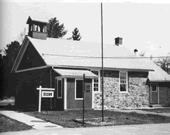 The school built for Fractional District One, known as the German School, was sited on Middlebelt Road, one-half mile north of Thirteen Mile. It was named for a settler named German. This school is one of the few still standing.
The school built for Fractional District One, known as the German School, was sited on Middlebelt Road, one-half mile north of Thirteen Mile. It was named for a settler named German. This school is one of the few still standing.
In District Two, the Nichols School was a main center of activity for the people in the North Farmington area. Located near Thirteen Mile and Farmington Roads, it operated as a day school and offered evening classes in spelling, singing and writing, as well as dramatic exhibitions performed by the students.
The Fractional District Two School, also known as Green School, was located in the northwest corner of the township south of Fourteen Mile, on property owned by A. E. Green. The land was apparently bartered away to the Walled Lake School District. For years School Superintendent G. V. Harrison tried unsuccessfully to get it back.
At the corner of Nine Mile Road and Halsted, the Thayer School of Fractional District Three stood until 1929, when its students were transported to Farmington High by bus, a first in Farmington school history.
The West Farmington School, located at Twelve Mile and Halsted, across the street from the cemetery, was known as "The Little Normal" for all of its graduates who became teachers. This Fractional District Four school was used as a store for awhile; the building burned in October, 1964. The District Four School once stood on Grand River Avenue, overlooking Independence Green and Chatham Hills apartments.
The current Special Education headquarters at Middlebelt between Nine and Ten Mile was constructed as the Noble School (for Adelbert Noble who owned the land) for District Number Six.
The most is known about the schools which served District Number Five. Built by Arthur Power, the first school was a tiny log hut on Shiawassee Street, East of where the Baptist Church now stands. Beginning in 1826, the school teacher during the winter months was Nathan Power, Arthur's son. To supplement his teaching salary, Nathan Power spent his after-school hours hunting wolves for the bounty money. During the summers, Parley Mead took over the teaching duties.
The tiny cabin was soon outgrown, and in 1835 Power was authorized to spend $375 on a new facility. Nathan Power met his budget, spending $372.50 on the construction of the "Little Red Schoolhouse" which probably stood near Ten Mile and Farmington Roads.
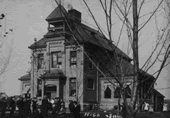 Power was entrusted with building the next school in 1852, a two-story frame building next to where Farmington Training/Conference Center stands today. The $729 building was moved in 1888 to what is now the parking lot of the Burger King at Warner and Grand River where it became the Apple Evaporator business until it burned.
Power was entrusted with building the next school in 1852, a two-story frame building next to where Farmington Training/Conference Center stands today. The $729 building was moved in 1888 to what is now the parking lot of the Burger King at Warner and Grand River where it became the Apple Evaporator business until it burned.
To replace the frame building, the Farmington Union School was built on the present site of Farmington Junior High School. It, too, fell victim of fire in 1918, only to be replaced that same year by a building then known as Farmington High School. Additions were made as the school population expanded, until the present Farmington High School on Shiawassee was built in 1953. The old school was then used as a junior high until its closing in 1976.
Prior to the building of the high school, education past the eighth grade was optional. If a student wished to go to high school, he/she could attend as a tuition student. Sometimes the school district would pay the entire tuition. In other cases, the cost was split between the parents and the Board. Transportation was not provided; students could choose any school that was near or had room for them. As a result, rural Farmington students attended not only Farmington High School (after it was built), but also Northville, Redford, Walled Lake, Pontiac and Detroit schools.
Educational attainment continued to grow in the Farmington area. Per the 1990 U.S. census, 42% of Farmington Hills adult residents over age 25 completed college, while 34% in Farmington received their degree. In both cities, twice as many people had graduate or professional degrees as had associate degrees even though the community is home to a junior college. For the state as a whole, only 17% completed college. The figure was 30% for Oakland County. The quest for excellence in education permeated the entire age spectrum.
According to figures from the 1995-96 Farmington Public Schools Annual Report, the graduation rate is 96.94%. Females represent 38.2% of dropouts; males, 61.8%. The district's 1994-95 retention rate was 96.94%. Graduation rate means the percentage of ninth grade students who graduate from high school within four years, adjusting for students who move in or out of the school district and to alternative programs. Of the graduating class, 85% enroll in college.
In 1996, the Farmington Public School District had approximately 12,000 students enrolled in 15 elementary, 4 middle, and 3 high schools, in addition to the 6 special service schools for adult or alternative education. The Farmington Public Schools was one of the area's largest employers in 1994 with over 1,400 employees!
Parochial education at all ages is also available within the community. Home schooling is increasing.
Alternatives for higher education include: the Orchard Ridge campus of Oakland Community College; William Tyndale College; and the Wayne State University College of Lifelong Learning, which opened a campus in a converted office building on Twelve Mile Road in 1995 and projects an ultimate enrollment of 10,000 within a few years.

The Founders
 In 1820, the Indian land was ceded to the U.S. government and was made available to settlers at a cost of $1.25 per acre. Such a bargain was attractive to Eastern land owners who wished to expand their holdings. One such Easterner was Arthur Power of Farmington, New York.
In 1820, the Indian land was ceded to the U.S. government and was made available to settlers at a cost of $1.25 per acre. Such a bargain was attractive to Eastern land owners who wished to expand their holdings. One such Easterner was Arthur Power of Farmington, New York.
In 1823, Power came to Michigan to survey the available land. He liked what he saw in the Farmington area; he purchased a large amount of acreage bounded by what is now Eleven Mile Road and Power to Alameda Road.
After returning to Farmington, New York to finish out the growing and harvesting season, Power, his two sons John and Jared, together with a hired hand and friends, David Smith and Daniel Rush, left for Michigan on February 1, 1824. After crossing the Niagara River, the party traveled by horse and sleigh to Windsor, where they arrived on February 15. Leaving Detroit by the Saginaw Detroit Trail (now Woodward Avenue) they passed through the towns of Hamilton's (Birmingham) Jenks, Sly, Durkee and Baker, finally reaching their destination on March 8, 1824.
The Power group set to work, first building a small log cabin and clearing the land of the many trees. Nine acres were cleared for wheat, six for corn. After three weeks, Daniel Rush, overcome by homesickness, set off on foot for Detroit and home.
Seven weeks after the Power group arrived, George Collins and his wife Cynthia, the first white woman in the area, came to Farmington. Shortly thereafter, Cynthia gave birth to the first white baby born in Farmington, son John W. The Collins located on unbroken land, built a log house and improved the land. They later moved to the village and opened a general store.
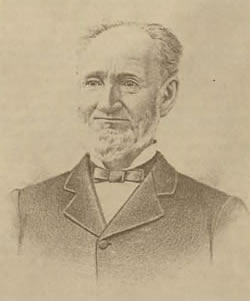 Dr. Ezekiel Webb, the first physician in what was then known as "Quakertown" was a friend of Arthur Power. He became the first Postmaster in 1825, but left the area a few years later, leaving his postmaster duties to George Collins.
Dr. Ezekiel Webb, the first physician in what was then known as "Quakertown" was a friend of Arthur Power. He became the first Postmaster in 1825, but left the area a few years later, leaving his postmaster duties to George Collins.
In 1825, Seth Warner and his family arrived in Farmington, when son P. Dean was three years old. P. Dean left Farmington at age fourteen for nine years, to work as a clerk and study in Detroit. In 1845 he returned and went into the merchandising business. Later he was elected to the State House of Representatives where he served as Speaker of the House. Warner had married Rhoda Botsford. Because the couple could have no children of their own, they adopted a boy and a girl. This son, Fred Warner, went on to become a State Representative and later the first Michigan Governor to serve three terms. Local historian Jean M. Fox documented Governor Warner's influence on public policy in her 1988 biography, I Went to the People: Fred Warner, Progressive Governor.

Government
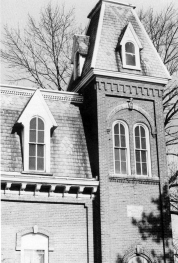 As transportation improved and the area became more accessible, the population grew, mandating incorporation and stronger government.
As transportation improved and the area became more accessible, the population grew, mandating incorporation and stronger government.
The initial organization of the area was done at the Quaker meetings when business could be discussed on a monthly basis.
Change began March 30, 1827 when the State Congress, at the urging of Lewis Cass, passed an act which gave people of a township the privilege of electing all township officers, with the exception of judges, clerks, and sheriffs. As Farmington Township was created April 12, 1827, as well as the townships of Oakland, Troy, Bloomfield and Pontiac, the people of Farmington were among the first to be able to elect their own officers.
In that first election the people chose Amos Mead as their Township Supervisor; Robert Wixom as Township Clerk; William Yerkes, Phillip Marlatt and Samuel Mead as assessors; Warham Lee, John Gould and John Power, Highway Commissioners; Rufus Thayer and Erastus Ingersol as Overseers of the Poor; George Collins and Robert Wixom, Pound Keepers; Postmasters were Benjamin Wixom, Samuel Mead, Samuel Maxwell and Wardwell Green; and the Fence Viewers were Samuel Mead, Samuel Mansfield, Wardwell Green and George Tibbets.
In 1867, one square mile of land centered around Grand River and Farmington Roads, bounded by Farmington Junior High to the east and Oakwood Cemetery to the west, was incorporated as the Village of Farmington. The area is now known as the Historic District. In 1926 the Village became a fifth class city. Since then land has been annexed to the west, south, and east to increase the area and tax base.
After incorporation, the city operated under a "strong mayor" government until 1951 when the system was changed to the present city manager government in an attempt to improve the efficiency of government operations.
Within what remained of the township, Wood Creek Farms Village was incorporated in 1957, a one square mile residential area bounded by Twelve Mile Road, Middlebelt, Thirteen Mile, and Inkster Road. One year later another residential area, the Village of Quakertown, was incorporated. In 1972, the township and both villages voted to become the City of Farmington Hills. It, too, operated under a strong city manager form of government in which the city manager heads the government; the city council elects one of its members to serve as mayor. In 1994, residents of Farmington Hills voted to amend their city charter to directly elect a mayor. In 1995, Aldo Vagnozzi became the first mayor directly elected, although the city charter retains a strong city manager form of government.

Religion
See Also:
- The Online Slide Show of Historic Churches in the Farmington Area
- Places of Worship in the Farmington Community
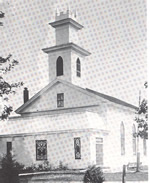 These early settlers were deeply religious, mostly Quakers (the first of this group in Michigan). Their first meetings were held in a small house built on land donated by Arthur Power. Next to this church was their burial ground, which can be seen from Gill Road. The Quaker movement was short-lived, however, fizzling out due to both death of the members and a lack of initiative on the part of their leaders to recruit new members.
These early settlers were deeply religious, mostly Quakers (the first of this group in Michigan). Their first meetings were held in a small house built on land donated by Arthur Power. Next to this church was their burial ground, which can be seen from Gill Road. The Quaker movement was short-lived, however, fizzling out due to both death of the members and a lack of initiative on the part of their leaders to recruit new members.
While the number of Quakers was dwindling, the populations of other denominations were growing. Several churches soon dotted the landscape.
The First Presbyterian Church was founded on August 13, 1826 at the home of Amos Mead, in response to the urging of a David Ruggles of Pontiac. Among its charter members was Seth Warner. In 1833 a church was built on the southeast corner of Halsted Road and Eleven Mile. It was later moved into the village of Farmington. After the move, the church population went into a decline; it was dropped from the Presbytery rolls in 1885, not to be revived until October 25, 1953, when Presbyterians met in the cafeteria of the Farmington High School.
Samuel Mead, the brother of Amos, was instrumental in the organization of the Baptist Church in Farmington, beginning in 1826. By 1835 they had moved into a frame building at Twelve Mile Road and Halsted Road, now the site of the West Farmington Cemetery. Chauncy Wolcott served as minister until 1857 when the congregation split. Wolcott and his followers moved to a church between Thirteen and Fourteen Mile, where the North Farmington Cemetery is now located. The remaining forty-three members organized and built a church on Shiawassee Road; the 28' x 40' frame structure was built at a cost of $1,680.
The Methodists met irregularly until the summer of 1827, at which time they began holding their meetings in members' homes. It was not until 1840, when Ebenezer Stewart donated land for a church at the southeast corner of Warner and Shiawassee, that they were able to construct a house of worship. After many delays, the church, 46' x 56', was finally finished in 1844, at a cost of $3,000. The church burned in February, 1920; it was rebuilt two years later on a site at Warner and Grand River.
In 1853 the Universalists constructed a $900 church on Warner, between Shiawassee and Grand River. This building was recently moved to its present location on the Gibson "Centennial" Farm on Halsted Road, a mile north of Grand River.
Other denominations came, grew and built their own churches and synagogues. Now over fifty dot the area. The religious groups reflect the increasing multiculturalism of the community.

Social Life
 While business took up a large part of the residents' time and attention, social life played its part in the community's development as well. First the mills, taverns, public houses and schools served as centers for meeting and entertainment, but soon the diverse social needs of the people were met in other ways. Early organizations were formed; the Oakland County Agricultural Society in 1830 led to the formation of the Farmington Grange, No. 267, Patrons of Husbandry in the 1870's, with 59 male and 55 female charter members.
While business took up a large part of the residents' time and attention, social life played its part in the community's development as well. First the mills, taverns, public houses and schools served as centers for meeting and entertainment, but soon the diverse social needs of the people were met in other ways. Early organizations were formed; the Oakland County Agricultural Society in 1830 led to the formation of the Farmington Grange, No. 267, Patrons of Husbandry in the 1870's, with 59 male and 55 female charter members.
The Farmington Riflemen was a military organization begun in 1830. The men trained at Auburn or Walled Lake with other militia. Known as "minute men", they were supposed to be ready for call-up in the event of some emergency on the (old) Northwestern frontier. The organization lasted until after the Civil War, when it quietly died.
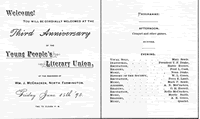 Farmington Literary Club Program When the Village of Farmington was incorporated in 1867, an ordinance was written to regulate circuses, caravans and shows. Most of these extravaganzas took place in the Town Hall, which hosted political and patriotic rallies, plays, (some of which were presented by the original Farmington Players organized in 1898), basketball games (in this case the Town Hall functioned as the school gymnasium) musicals, dances, dinners, card-playing, and home talent shows. The Hall provided a meeting place for the Ladies Literary Club (forerunner of the library), the Young People's Literary Union, the Farmington Women's Club, the Grand River Pedro Club (music), and the You-go-I-go Pedro Club.
Farmington Literary Club Program When the Village of Farmington was incorporated in 1867, an ordinance was written to regulate circuses, caravans and shows. Most of these extravaganzas took place in the Town Hall, which hosted political and patriotic rallies, plays, (some of which were presented by the original Farmington Players organized in 1898), basketball games (in this case the Town Hall functioned as the school gymnasium) musicals, dances, dinners, card-playing, and home talent shows. The Hall provided a meeting place for the Ladies Literary Club (forerunner of the library), the Young People's Literary Union, the Farmington Women's Club, the Grand River Pedro Club (music), and the You-go-I-go Pedro Club.
Square dances and masquerade balls were sponsored by the hotels as well, but the best attended of such events were the popular dances held during the Twenties in the barn on Heliker farm, just west of present Harrison High School.
Movies arrived in 1915, billed as silent "Flicker Shows". They were shown in the Methodist Community Hall, with admission at 15 cents and 25 cents.
When Farmington High School was built, it became the second most popular place in town, after the Town Hall, as the site of sports events, student performances, club meetings and presentations by the reorganized Farmington Players.
By 1995, the area had a wealth of recreational facilities including 5 parks with a total of almost 500 acres, 5 public indoor swimming pools, 3 private swim clubs, 1 private and 3 public golf courses, 22 outdoor public tennis courts, 4 natural ice rinks, and 1 public indoor rink with two surfaces. The Farmington Hills Special Services Department offers an array of sports activities for all ages during all seasons. Intramural sports (baseball, hockey, soccer, etc.) are available, organized by the public schools, clubs, and the city's recreation department.
Culturally, the area supports a philharmonic, community band and a chorus. The Farmington Artists Club has a juried show annually. The Farmington Musicale and the Farmington Players, which uses a converted barn on Twelve Mile Road, offer venues to the public. Other local organizations, such as the Farmington Historical Society and the Farmington Genealogical Society, cultivate an interest in our heritage. Senior adults find a variety of programs of interest at the William Costick Activities Center, supported by the City of Farmington Hills. Governor Warner's home has been converted to an historical museum, filled with the grace and ambience of a by-gone era.

Transportation
 Modes of transportation to these out-lying areas and around Farmington changed and developed quickly. Originally, Shank's Mare (walking), horseback, horse and buggy, wagons, and sleighs were the only means of getting around, but this situation did not last long.
Modes of transportation to these out-lying areas and around Farmington changed and developed quickly. Originally, Shank's Mare (walking), horseback, horse and buggy, wagons, and sleighs were the only means of getting around, but this situation did not last long.
When Lansing was made the capital city of the state, the need for a good road between Detroit and Lansing was created. Grand River was the road, but definite improvements were needed. As a result, the Detroit-Howell Plank Road was built. The road was built according to the General Plank Road Act of 1850, which specified that it be sixteen feet wide, ample shoulder on each side, and tollgates be established every five miles, charging fixed rates by vehicle type. Construction began in 1851.
The oak planks were placed directly on the soil, not a wise decision as the planks later rotted and became treacherous. Ditches were opened, culverts were raised, and the entire surface was spread with lime coated gravel, which acted as a protective covering.
In all, six toll stations were established; three were of importance to Farmington history.
This road improvement and the tollgates led to the development of stagecoach lines running the route, and inns to accommodate the road's travelers. Indeed, stagecoach travel increased to two four-horse stages per day, which could each accommodate twenty-four passengers, plus freight; however, it was not unusual for nine of the passengers to ride perched on top. These coaches, coupled with the hundred wagons which passed through each day, created heavy demand for inns and taverns at which to stop, rest and refresh.
The best-known of these inns is the Botsford Inn, located at Grand River near Middlebelt. Its story is best described by the historical marker now standing in front of the inn:
"This historic Inn, one of the oldest in Michigan providing food and lodging was built as a home in 1836 by Orren Weston. In 1841 it was converted into a tavern by Stephen Jennings. Known as the Sixteen Mile House it was the stagecoach stop . . . Milton C. Botsford acquired the Inn in 1850. It became a popular meeting place for drivers, farmers and travelers to and from Detroit. Henry Ford, who had first seen the Inn while courting future wife, Clara, in a horse and buggy, purchased the Inn from the Botsfords in 1924 and restored it. The Fords operated it until 1951. Ownership was then taken over by John Anhut, who has made two large additions to the original building."
The once greatest hostelry in the Michigan wilderness was the Walker/Wixom Tavern. Built in 1827 by Solomon Walker, it was located on the south side of Grand River Ave. at the point where Ten Mile breaks away, just west of Halsted Road. The first Township meetings were held here. Mr. Walker sold the Tavern to Harrison Philbrick in 1839. Harrison sold the Tavern to Robert Wixom 6 years later. It was a popular stage coach stop for many years. It reverted to a private residence and fell into disrepair, shortly thereafter.
Another such establishment was the H. Swan Hotel, later known as the Owen House (1875 - 1919) claimed to be "the finest inland hotel in the state" by its second owner, L.D. Owen. The Swan was located on the corner of Farmington Road and Grand River. In later years, it boasted of electric lights, steam heat and a bowling alley, all for $1.50–$3.00 a day.
 Another inn still standing at Eleven Mile and Power Road, but no longer in operation, was the Philbrick Tavern, built in 1824–a reported stop on the Underground Railroad.
Another inn still standing at Eleven Mile and Power Road, but no longer in operation, was the Philbrick Tavern, built in 1824–a reported stop on the Underground Railroad.
An interurban electric railroad, known as the Detroit United Railroad, or the D.U.R., began service in 1901. The main junction was at Grand River and Orchard Lake. A power plant was built by the Detroit and Northwestern Railway in 1899, and a car barn across the street. Passengers could transfer to the Orchard Lake Route north to Pontiac, or could stay on and continue through town to Northville.
During its nearly thirty year existence, the D.U.R. was profitable for both its owners and Farmington. Each car had a motor man and a brakeman; many Farmington men were employed. But eventually the D.U.R. fell victim to the automobile, the Depression, and taxes on the Railroad's right-of-way.
For a short time the service was replaced by a Farmington to Five Points in Redford run by the Detroit Department of Street Railways (D.S.R.), but the automobile was eventually triumphant.
Today, the automobile continues to dominate the scene, racing along the three major freeways: I-696, I-96 and I-275. Limited public bus transportation is available, through a shared regional bus system for Wayne and Oakland Counties. The large and numerous automobile dealerships that have grown in the area reflect on our proximity to the Motor City and our preference for independent travel.

Underground Railroad
 An interesting bit of Farmington's history which is believed to be part reality, part speculation, is the story of Farmington's part in the Underground Railroad.
An interesting bit of Farmington's history which is believed to be part reality, part speculation, is the story of Farmington's part in the Underground Railroad.
The peace-loving Quakers were supporters, of course, of the Abolitionist ideals of freedom for all, so it is natural to assume that they would give what aid they could to runaway slaves traveling to Canada. It is believed that the Farmington routes were used only when the direct passage to Detroit was blocked by the watchfulness of slave hunters.
Although there is no actual evidence to support the claims, several buildings in Farmington are said to have been stations along this route. The first was the old Quaker Meeting House, where Arthur Power lived after 1836. Located on Gill Road, it is now a Convalescent Home.
Other purported stations on the Underground Railroad include: the Philbrick Tavern at Eleven Mile Road and Power, now a private residence; the basement of the First Baptist Church; a home owned by a Judd Webster, which stood where the Thayer-Rock Funeral Home is now located; and the Shaupter Place on Grand River, which is now Executive Office Supply.
While there is no proof that any of these buildings may have been involved, the story of Wellington Hullm, better known as Pete, the T.V. Man, one of the area's first black residents, does give some credence to the legend. Hullm's ancestors in Farmington date back to the 1850's; the property he owned on Ten Mile Road had been in the family since 1870. Ellen Wilson, Hullm's great-grandmother was born a slave in 1836. In 1850, she and her husband Aaron came to Michigan. They went on to Canada and remained there for three years, obtaining Canadian citizenship and, as a result, their freedom. The two returned to Farmington; it is believed they lived in several places, including a house at Nine Mile and Grand River.
When Hullm was young, he left his parents in Detroit to live with relatives in Farmington. He remembers accompanying his great-grandmother to the house at Eleven Mile and Power frequently. Though he doesn't really know the reason for the visits, he speculates that it may be because of the house's involvement with her journey to freedom. Hullm's story, combined with the rememberings of other stories residents heard from their grandparents, is evidence that some members of the community were indeed involved with the Underground Railroad.
Even with the history of the Underground Railroad, the community remained largely white through the 1970's. With the 1990 census, the population of the Farmington area remained predominantly white although there were significant increases in minority populations. In Farmington Hills, the percentage of minority population rose from 2.8% of the population to 7.3%; while in Farmington, the percentage went from .9% to 3% of the total population. The largest minority population was Asian, with 4.8% of the Farmington Hills total and 1.5% of the Farmington total. There were a large number of nationalities represented in that group, including: Chinese, Filipino, Japanese, Indian, Korean and Thai. Black population was 1.8% of the Farmington Hills total and just under 1% of the Farmington total. The Hispanic population was 1.1% of the Hills' population and .77% of the Farmington total.
The concept of ethnic diversity in the community was vividly illustrated by the fact that in 1990, of the 69,733 people over the age of five in Farmington Hills, 8,015 indicated that they speak a language other than English at home and 2,277 of those indicated they do not speak English very well. For Farmington, 512 people spoke a language other than English at home and 162 replied they did not speak English very well. In addition, almost 10% of the population of Farmington Hills responded that they were born in another county. For Farmington, the figure was 6.8%.
Such changing ethnic diversity mirrors a national trend. Diversity in the school population is often a good indicator of other ethnic population characteristics. A May, 1991 survey of students in the Farmington Public Schools found that 460 students identified 24 primary family languages other than English spoken in the home. Of those 24 languages, the majority spoken were: Japanese, Chaldean, Arabic, Albanian, and Asian Indian.
Diversity was identified as a community concern that resulted in the creation of the Multi-Cultural Multi-Racial Council in the early 1990's. The Council, which represents schools, government, the clergy, business, service groups and residents, has the mission to enhance the basic human dignity of all people and to assure that all residents of Farmington and Farmington Hills feel welcome and comfortable in their city, schools, and neighborhood. The Council promotes community awareness and acceptance of diversity to improve race relations and to improve a climate which promotes inclusivity.
